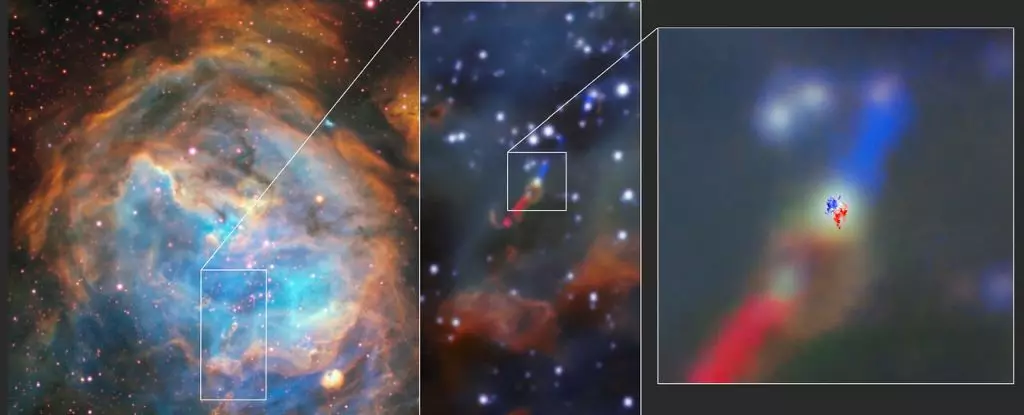In a groundbreaking discovery, astronomers have recently detected the presence of an extended disk composed of dust and gas that orbits a star located in a distant galaxy. While the formation of star systems with disks of this nature is a normal occurrence in our own Milky Way galaxy, this is the first time that such a phenomenon has ever been observed beyond our own galactic home. The remarkable feature was spotted in the Large Magellanic Cloud, a dwarf galaxy situated approximately 179,000 light-years away from us. This remarkable discovery challenges our assumptions about the universality of star formation processes, as we have previously been unable to observe the intricacies and variations of these processes outside of our own galaxy.
The birth of stars begins with dense clumps found within molecular gas and dust clouds located in the vast expanse of interstellar space. As these clumps accumulate sufficient density, they collapse due to gravitational forces, resulting in the initiation of a spinning motion. Subsequently, the clumps actively attract additional material from the surrounding cloud, which then forms a rotating disk around the equator of the protostar. Unlike a random influx of material, this process perpetuates an ordered and controlled descent of matter onto the protostar, resembling a steady stream of water flowing down a drain. Once the star formation process is complete, the remaining disk material clumps together to form the various components of a planetary system, including planets, asteroids, meteors, comets, and residual dust. This disk formation ultimately accounts for the relatively flat trajectory of our own Solar System, with its planets orbiting the Sun in a uniform plane.
The Atacama Large Millimeter/submillimeter Array (ALMA), a powerful radio telescope, has facilitated the imaging of numerous disks at varying stages of development within our Milky Way galaxy. Some of these observed disks exhibit clear gaps, which are believed to emerge as a result of the aggregation of planets while in orbit. However, given the increasing distance of the disk from our observation point, the resolution of such details becomes progressively more challenging, even with the assistance of advanced telescope technology.
The investigation into extragalactic stellar disks was initiated by astronomer Anna McLeod and her fellow researchers following the identification of a jet in the HH 1177 system using the Multi Unit Spectroscopic Explorer (MUSE) instrument on the Very Large Telescope. These jets are characteristic manifestations of the star formation process, wherein some of the swirling material surrounding the nascent star is expelled along magnetic field lines towards the poles, culminating in a forceful ejection of matter into space. Utilizing ALMA, the team sought to ascertain whether they could observe the presence of a disk in the core of this dusty star formation region by examining signs of rotation.
The ALMA data confirmed clear indicators of rotation within the observed star. Through their analysis, the research team deduced that the star in question is both remarkably young and massive, still drawing sustenance from its surrounding disk. While this scenario is not uncommon, there exists a key distinction between the HH 1177 disk and the protostellar disks observed within the Milky Way. Specifically, the HH 1177 disk is visible at optical wavelengths, an uncommon feature that can be attributed to the interstellar environment prevalent in the Large Magellanic Cloud. The diminished presence of dust within this cloud results in lower levels of material enveloping the HH 1177 star compared to the considerable shroud typically surrounding young, massive stars in the Milky Way. Consequently, this discovery holds great importance for investigating not only the diverse ways in which stars develop in varying environments but also the limitations imposed by these environments on the process of star formation.
As emphasized by astronomer Anna McLeod, we currently find ourselves in the midst of an era characterized by rapid technological advancements in astronomical facilities. The ability to make such groundbreaking observations across vast cosmic distances demonstrates the remarkable progress we have made in expanding our knowledge of the universe. Through continued technological improvements and ambitious scientific endeavors, we will undoubtedly uncover further insights into the mechanisms underpinning star and planetary formation. The recent detection of the first extragalactic accretion disk serves as a testament to the importance of pushing the boundaries of scientific exploration, shedding light on the extraordinary intricacies of the cosmos.


Leave a Reply